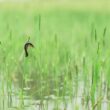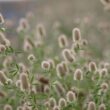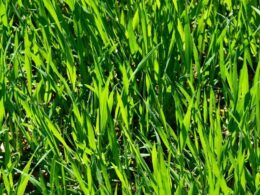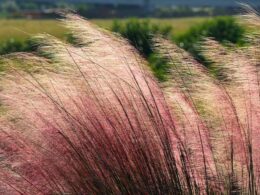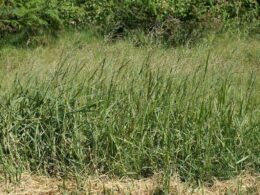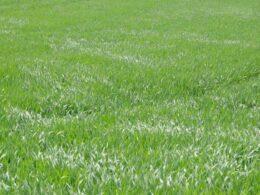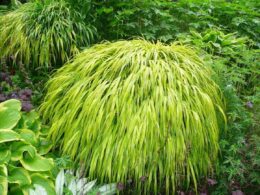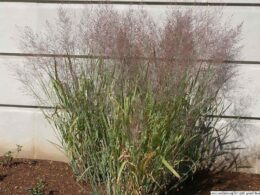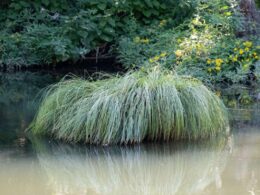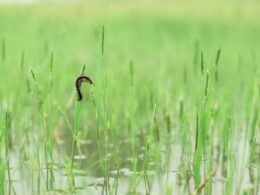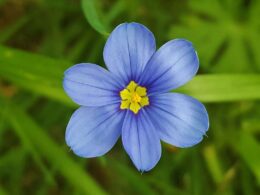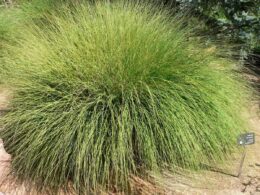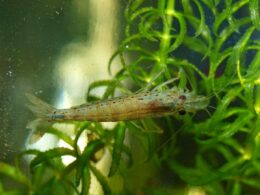Johnson Grass: Basic Information
Johnson Grass (Sorghum halepense) is a fast-growing, invasive and perennial grass that is native to Eurasia and is a plant in the family Poaceae. It was introduced to the United States in the early 1800s as a forage crop, but it has since spread across the country and now grows in all 50 states. Johnson grass is considered a weed by many farmers and gardeners because it is very difficult to control. The plant spreads rapidly by both seed and rhizome, and it can quickly crowd out other vegetation.
Sorghum Halepense Appearance
Johnson grass typically grows to a height of 3-6 feet, but can occasionally reach up to 7 feet. The leaves are rolled in a bud and can be up to 24 inches long. The flower heads are small and yellow, and they produce small, reddish-brown seeds. The leaves are linear and have a pointed tip. The leaf blades are rough and hairless. The flowers are purplish and borne in inflorescence known as spikelets.
The plant has a deep root system that helps it to tolerate drought conditions. The flower head is a panicle and can be up to 1.5 feet long. In the United States, Johnson grass is classified as a noxious or quarantine weed in nineteen states.
Johnson Grass: Habitat and Distribution
The plant is thought to have been introduced to North America by early settlers, who used it for livestock feed. It has since been introduced to other parts of the world, and can now be found in Africa, Asia, Australia, Europe, and North and South America. Johnson grass typically grows in open, sunny areas such as fields, roadsides, and waste places. Johnson grass spreads rapidly through its prolific seed production, and it can quickly crowd out native plants.
How Is Johnson Grass Spread?
Johnson grass spreads primarily by rhizomes, which are underground stems that can send out new shoots some distance from the parent plant. The roots of Johnson grass are also very invasive, and the plant can easily outcompete other plants for water and nutrients. As a result, Johnson grass is considered to be a noxious weed in many parts of the world.
Johnson Grass as Forage Alternative
Despite the fact that Johnson grass is considered an invasive plant, it is also good forage. It can be found growing in pastures and meadows across the country. When managed properly, it can provide forage for cattle, horses, sheep, and other grazing animals. Johnson grass is most commonly grazed in the spring and fall when it is actively growing.
Johnson Grass Is Considered a Weed
The plant invades pastureland, cropland, and natural areas, crowding out native vegetation. It is difficult to control because of its rapid growth and prolific seed production. It is a very aggressive plant that can quickly take over a garden or field. The grass is difficult to control and eradicate once it has established itself.
Johnson Grass produces a large amount of seed that can spread easily and quickly result in a new infestation. Furthermore, Johnson grass is poisonous to many animals, including cattle, horses, and sheep. For these reasons, Johnson grass is considered a serious agricultural pest and a serious threat to food production.
Is Johnson Grass Poisonous to Horses and Other Animals?
While it is an important food source for livestock, Johnson grass can also be poisonous to animals. The toxic component of Johnson grass is prussic acid, more commonly known as hydrogen cyanide. The poison, which is found in the leaves and stems of the plant, can cause liver damage and respiratory problems if eaten in large quantities. In severe cases, it can even lead to death. Livestock are particularly vulnerable to Johnson grass poisoning, as they often graze on the plant without knowing that it is dangerous. It is important to be aware of possible danger and control Johnson grass cultivation.
Control Measures
Johnson grass is a troublesome perennial weed in many crops, pastures, and lawns throughout the United States. Johnson grass can reduce crop yields by up to 80%, and it is very difficult to control once it becomes established. There are several effective control measures that can be used to control Johnson grass.
Mowing
Mechanical methods of Johnson grass control include hand-pulling, hoeing, and mowing. Hand-pulling is the most effective method for small infestations, but it can be time-consuming and difficult in larger infestations. Hoeing can be effective for small infestations, but it can also damage desirable plants. Mowing can be effective for large infestations, but it may need to be done multiple times over the course of a growing season to be effective.
Tillage
Johnson grass can reduce crop yields by competing for resources like water and nutrients. It can also act as a host for diseases and pests. The best way to control Johnson grass is through tillage. Tillage involves overturning the soil with a plow or other tool. This disrupts the roots of the weed and prevents it from regrowing. It also exposes the weed to sunlight, which hastens its death. However, tillage must be done carefully to avoid damaging crops. Timing is also critical; tillage should be done when the weeds are young and actively growing.
Herbicide
One of the most popular herbicides for Johnson grass control is glyphosate. Glyphosate works by inhibiting an enzyme that is essential for plant growth. Glyphosate is a broad-spectrum herbicide that is effective against Johnson grass, and it can be applied either as a spray or as a directed treatment to the base of the plant. However, glyphosate is also non-selective, meaning that it will kill any plant that it comes in contact with. As a result, care must be taken to avoid harming other plants when using this herbicide.






